Hassani S. Mathematical Physics: A Modern Introduction to Its Foundations
Подождите немного. Документ загружается.

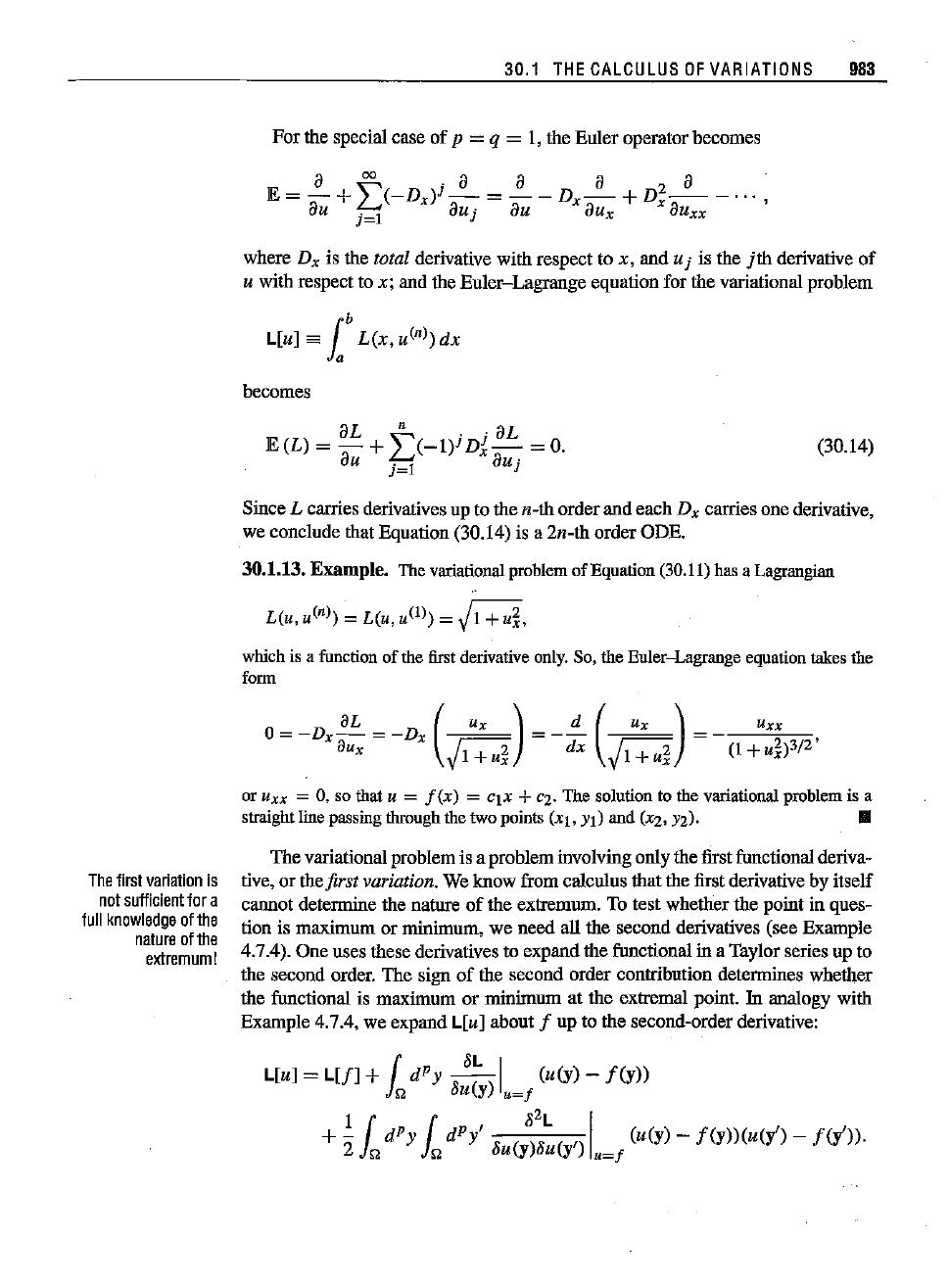
30.1
THE
CALCULUS
OF
VARIATIONS
983
For the specialcase of p =q =1, the Euler operatorbecomes
a
~
·a
a a
za
.
IE= - +
L,,(-Dx)J-
= - - D
x-
+D
x--
-
...
,
au
j=l
auj au aux
[Ju
xx
where D
x
is the total derivativewith respect to
x,
aod U j is the
jth
derivativeof
U withrespect to x; aod the Euler-Lagrange equation for the variationalproblem
becomes
aL
n
.'
aL
IE(L)
= - +
L(-l)l
Di-
=
o.
au
j=l
aUj
(30.14)
uxx
The
first
variafion
is
not
sufficientfor
a
full
knowledge
ofthe
nature
of
the
extremum!
Since L carries derivatives up tothe n-thorderaod each D
x
carriesone derivative,
weconclude that Equation
(30.14) is a 2n-thorder ODE.
30.1.13. Example. The
variational
problem
of
Equation
(30.11)
hasa
Lagraugiau
L(u, u
Cn)
=L(u, u(1) = J1+
ui,
which
is a
function
of the
first
derivative
only.
So, the
Euler-Lagrange
equation
takes
the
form
et.
(u
x)
d ( U
x
)
O=-D
x aux
=-D
x
Jl+ui
=-dx
Jl+ui
=
oruxx = 0, so
that
u =
f(x)
=
cj
x +cz. The
solution
to the
variational
problem
is a
straight
line
passing
through
thetwo
points
(xj
,
YI)
aud(xz, yz).
III
Thevariationalproblemisaprobleminvolvingamy thefirstfunctionalderiva-
tive,or the
first variation. Weknow from calculus that the firstderivativeby itself
caooot detennioe the nature of the extremum. To test whether the point in ques-
tion is maximum or mioimum, we need
all the second derivatives(see Exarople
4.7.4). One uses these derivativesto expaodthe functional10a Taylorseriesup to
the second order. The sign of the second order contribution determines whether
the functional is maximum or minimum at the extremal point, 10 aoalogy with
Exarople4.7.4, we expaod
L[u] about f up to the second-orderderivative:
L[u] =
L[f]
+ (
dPy
, 8(L) I
(u(y)
-
f(y))
l«
aU Y
u=f
1
({
8
zL
I
+
2:}0,
dPy
}o,
dPy'
8u(y)8u(y')
u=f
(u(y)
-
f(Y))(u(y')
-
f(Y'))·

984 30.
CALCULUS
OF
VARIATIONS, SYMMETRIES,
AND
CONSERVATION
LAWS
The integrals have replaced the sums of the discrete case of Taylor expansion of
the multivariable functions. Since we are interestedin comparing
uwith the f that
extremizes the functional, the second term vanishes and we get
11
1 8
2L
I
L[u] =
L[f]
+
2:
n
dPy
n
dPy'
8u(y)8u(y')
u~f
. [(u(y)
-I(y»(u(y')
-
f(y'»]·
(30.15)
Joseph
Louis
Lagrauge
(1736-1813) was born Giuseppe
Luigi Lagrangia but adopted the French version
of
his name.
He was the eldest of eleven children. most of whom did not
reach adulthood. His father destined him for the
Iaw-a
pro-
fession that one of his brothers later
pursued-and
Lagrange
offered no objections. But having begun the study
of
physics
and geometry, he quickly became aware of his talents and
henceforth devoted himself to the exact sciences. Attracted
first by geometry, at the age
of
seventeen he turned to analy-
sis, then a rapidly developing field.
In 1755, in aletterto the geometerGiulio
daFagnano,
Lagrangespeaks
of
one
of
Euler's
papers published at Lausanne and Geneva in 1744.
The
same letter shows that as early as
the
end
of
1754 Lagrange had found interesting results in this area, which was to become
the
calculus
of
variations (a term coined by Euler in 1766). In the same year, Lagrange
sentEuler a summary, written in Latin,
of
the purely analytical methodthathe used for this
type
of
problem. Euler replied to Lagrange that he was very interested in the technique.
Lagrange's merit was likewise recognized in Turin; and he was named, by a royal decree,
professor at the Royal Artillery School with an annual salary
of
250
crowns-a
sum never
increased in all the years he remained in his native country.
Many
years later, in a letter to
d'Alemberl, Lagrange confirmed that this method
of
maxima
and minima was the first fruit
of
his
studies-he
was only nineteen
when
he devised
it-and
thathe regarded it as his best
work in mathematics.
In
1756, in a letter to Euler that has been lost, Lagrange, applying
the calculus
of
variations to mechanics, generalized Euler's earlier work on the trajectory
describedby a materialpointsubjectto the influence
of
centralforces to an arbitrary system
of
bodies, and derived from it a procedure for solving all the problems of dynamics.
In
1757 someyoung Turinscientists, amongthemLagrange,foundeda scientific society
that was the origin
of
the Royal Academy
of
Sciences
of
Turin. One
of
the
main
goals
of
this
society was the publication
of
a miscellany in French and Latin,
Miscellanea
Taurinensia
ou Melanges de Turin, to which Lagrange contributed fundamentally. These contributions
includedworks on the calculus
of
variations, probability, vibrating strings, and the principle
of least action.
To enter a competition for a prize,
in 1763 Lagrange sent to the Paris Academy
of
Sciences a memoir in which he provided a satisfactory explanation
of
the translational
motion
of
the moon. Inthe meantime,the Marquis Caraccioli, ambassadorfromthe kingdom
of
Naples to the court
of
Turin,was transferredby his governmentto London. He took along
the youngLagrange, who until thenseems neverto haveleftthe immediatevicinity
of
Turin.
Lagrangewas warmlyreceivedin Paris, wherehe
had
beenprecededby his memoiron lunar
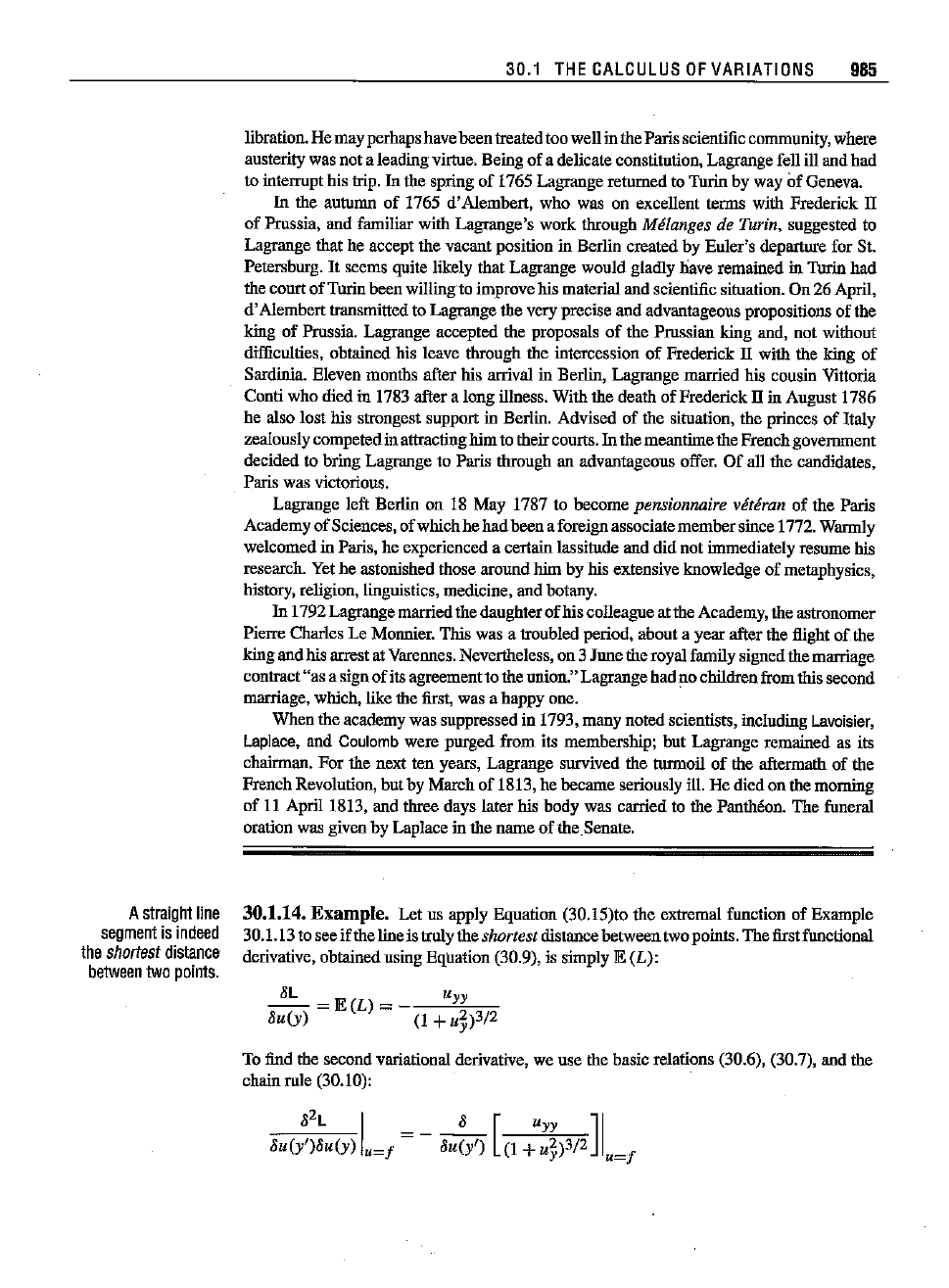
30.1
THE
CALCULUS
OF
VARIATIONS 985
libratian.Hemay
perhaps
havebeentreatedtoowellintheParisscientific
community,
where
austerity was not a leadingvirtue. Being
of
a delicate constitution, Lagrange fell
ill
and
had
to interrupt bis trip.
In
the
spring
of
1765 Lagrange returned to Tnrin by way
of
Geneva.
In
the autumn of 1765 d'Alembert, who was on excellent tenus with Frederick
IT
of
Prussia, and familiar with
Lagrange's
work
through
Melanges
de
Turin,
suggested to
Lagrange that he accept
the
vacant position in Berlin created by
Euler's
departure for St.
Petersburg. 11seems quite likely
that
Lagrange
would
gladly
have
remained in Tnrin
bad
the court
of
Turin
been
willing-to improvehis material and scientific situation. On 26 April,
d'Alemberttransmittedto Lagrangethe veryprecise and advantageouspropositions of the
king of Prussia. Lagrange accepted the proposals
of
the Prussian king and, not without
difficulties, obtained his leave through the intercession
of
Frederick II with the king
of
Sardinia. Eleven months after his arrival in Berlin, Lagrange married his cousin Vittoria
Conti wbo died in 1783 after a long illness. With
the
death
of
Frederick II in August 1786
he also lost his strongest support in Berlin. Advised
of
the
situation, the princes
of
Italy
zealouslycompeted
in attracting
him
to theircourts.In
the
meantimethe Frenchgovernment
decided to bring Lagrange to Paris through an advantageous offer.
Of
all
the
candidates,
Paris was victorious.
Lagrange left Berlin on 18
May
1787 to
become
pensionnaire
veteran
of the Paris
Academy
of
Sciences, of
which
he
had
been
a foreignassociate
member
since1772.
Wannly
welcomed
in Paris, he experienced a certain lassitude and did not immediately resume his
research. Yet he astonished those around
him
by
his extensive knowledge
of
metaphysics,
history, religion, linguistics, medicine, and botany.
In 1792 Lagrangemarriedthe daughter
of
his colleagueat the Academy,
the
astronomer
Pierre Charles Le Monnier. This was a troubled period,
about
a year after the flight
of
the
king
and
his arrest at Varennes. Nevertheless, on 3
June
the royalfamily signedthe marriage
contract
"as
a sign
of
its agreementto the union." Lagrange
had
no childrenfrom this second
marriage, which, like the first, was a
happy
one.
When
the academywas suppressed in 1793,
many
noted
scientists, including Lavoisier,
Laplace, and Coulomb were
purged
from
its membership; but Lagrange remained as its
chairman.
For
the next ten years, Lagrange survived
the
turmoil
of
the aftermath
of
the
French Revolution, but by
March
of
1813, he
became
seriously ill. He
died
on the morning
of
11 April 1813, and three days later his
body
was
earned
to
the
Pantheon. The funeral
oration was given by Laplace in the
name
of
the.Senate.
30.1.14.
Example.
Let us apply Equation (30.15)to
the
extremal function of Example
30.1.13to see if the lineis truly the
shortestdistance
between
two points. The firstfunctional
derivative, obtainedusing Equation (30.9), is simply IE
(L):
A
straight
line
segment
is
indeed
lhe
shortest
distance
between
two
points.
8L
--
=IE(L)
=
8u(y)
Uyy
To find the second variational derivative, we use the basic relations (30.6), (30.7), and the
cbain rule (30.10):
8
2L
I 8 [
Uyy
] I
8u(y')8u(y)
u=f
=-
8u(y')
(1 +
u~)3/2
u=f

dx
Xt ea dt '
986 30.
CALCULUS
OF
VARIATIONS, SYMMETRIES,
ANO
CONSERVATION
LAWS
=
-{(I
+u
2)-3/2
Buyy _ u
J(1
+u
2)-5/2
2u
~
II
y Bu(y') YY2 y
YBu(y')
u~f
=
B"(y-y')
I =
B"(y-y')
(
I
+u
2)3/2
(I +c
2
)3/2 '
y
u=f
1
becauseUyy =0 andUy =
C1
whenu =
f.
Inserting
this
in
Equation
(30.15),we
obtain
L[u]
=
L[f]
- 1
2
3/21X2dY
lX2dy'B"
(y -
y')(u(y)
-
f(y))(u(y')
-
f(y'))
2(1 + c
l)
X[ XI
I
lX2
d
2
=
L[f]
-
23/2
dy(u(y)
-
f(y))-d
2
(u(y)
-
f(y))·
2(1+c
l)
X[
Y
Thelast
integral
canbe
integrated
by
parts,
withthe
result
d I
X2
l
x2
[
d
]2
(u(y)
-
f(y))"d(u(y)
-
f(y))
-
dy
"d(u(y)
-
f(y))
Y Xl, Xl Y
=Obecauseu(Xj)
=f(Xj),
i =
1,2
Therefore,
I
lX2
[ d
]2
L[u]
=
L[f]
+ 2
3/2
dy
-d
(u(y)
-
f(y))
2(1 +c
l)
~x..:[
y~
~
always
positive
It follows that
L[f]
<
L[u],
i.e., that f indeed gives the shortestdistaoce.
III
30.1.15. Example. Iothespecialtheoryofrelativity,theelementoftheinvatiaot"length,"
or proper time, is given by ,j
dt
2
-
dx
2.
Thus, the total proper time between two events
(tl,
Xl) aod (t2, X2) is givenby
L[x]
=1
'2
jl-xTdt,
II
The
extremum
of this
variational
problem
is exactlythesameas inthe
previous
example,
theonly
difference
beingasign.In fact.the
reader
mayverify
that
connection
between
variational
problem
and
the
twin
paradox
BL[x] =
IE
(L)
=
X"
,
Bx(s) (I - x'f)3/2
and
therefore,
x =
f(t)
=
qt
+ C2
extremizes
the
functional.
The second
variational
derivative
canbe
obtained
as
before.
It isleftforthe
reader
toshow
that
in thecaseat
hand,
L[f]
>
L[x],
i.e., that f givesthe longest proper time. Since the function
f(t)
=
Cjt
+
C2
corresponds
toan
inertial
(unaccelerated)
observer,
we
conclude
that
30.1.16. Box. Accelerated observers measure a shorter
proper
time between any
two events than inertial observers.
This is the content
of
the famous twin paradox, in which the twin who goes to a
distant
galaxyandcomesback
(therefore
being
accelerated)
will
return
younger
than
her
(noaccelerated)twin.
III
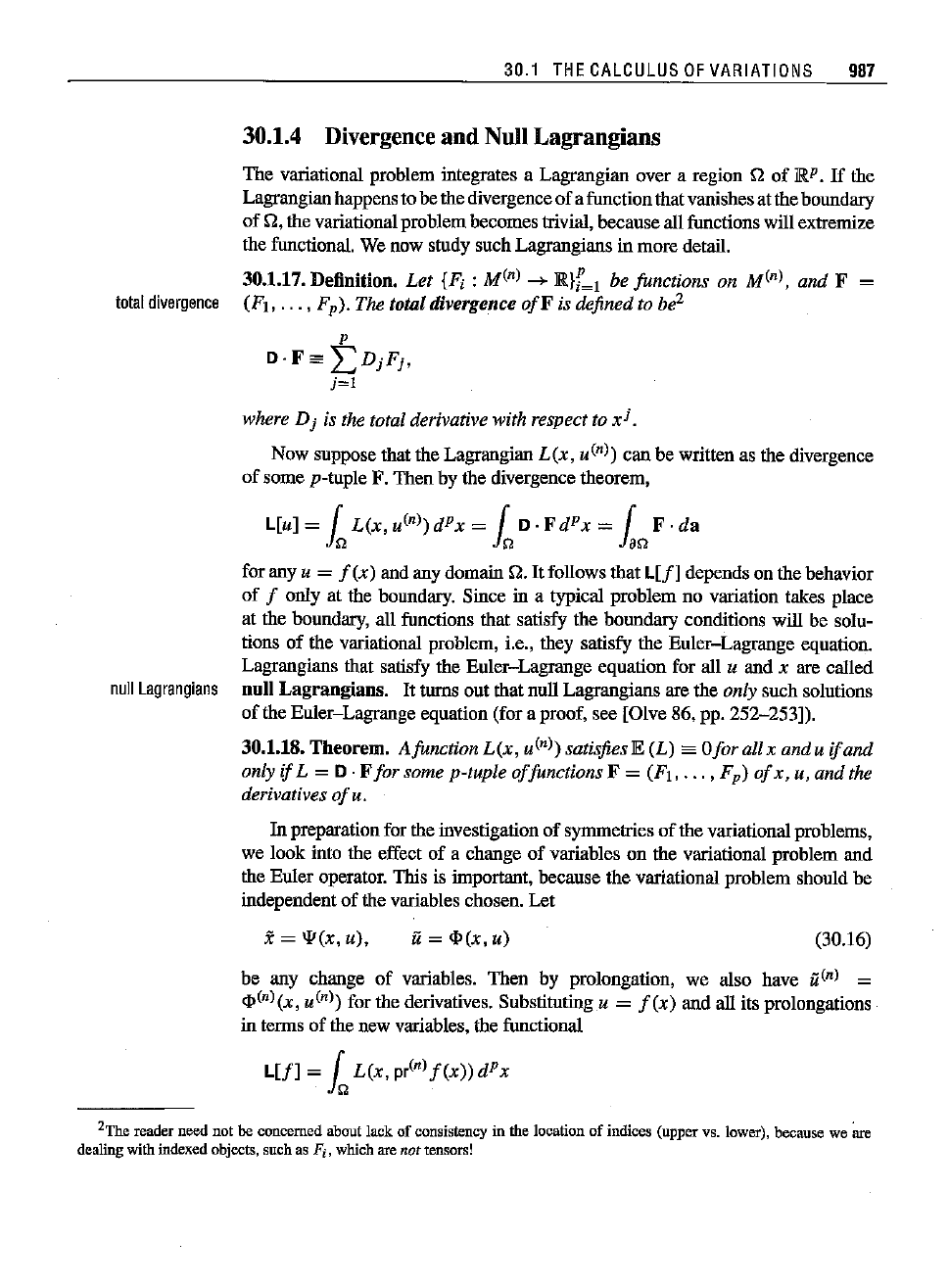
30.1
THE
CALCULUS
OF
VARIATIONS
987
30.1.4 Divergence and NullLagrangians
The variational problem integrates a Lagrangian over a region Q
of
JRP.
If
the
Lagrangianhappensto be the divergence
of
afunctionthatvanishesat the boundary
of
Q,
the variationalproblem becomestrivial, becauseall functions will extrentize
the functional. We now study suchLagrangians in
more
detail.
30.1.17. Definition.
Let
(Fi : M(n) --+
JR}r~1
be functions an
u»,
and F =
total
divergence
(Fl,
...
, F
p
). The total divergence
ofF
is defined to bt?
P
D·F",
LDjFj,
j=l
where Dj is the total derivative with respect to
xi.
Now
suppose that the Lagrangian
L(x,
u(n»
can
be written as the divergence
of
some
p-tuple
F.
Then
by the divergence theorem,
L[uJ=
{L(x,u(n»dPx=
{D.FdPx=
(
F·da
I
n
I
n
Jan
for any u =
f(x)
and any domain
Q.
It
follows that
L[J]
depends on the behavior
of
f only at the boundary. Since in a typical problem no variation takes place
at the boundary, all functions that satisfy the boundary conditions will be solu-
tions
of
the variational problem, i.e., they satisfy the Euler-Lagrange equation.
Lagrangians that satisfy the Euler-Lagrange equation for all
u
and
x are called
null
Lagrangians
null
Lagrangians.
It
turns out that null Lagrangians are the only such solutions
of
the Euler-Lagrange equation (for a proof, see [Olve 86, pp. 252-253]).
30.1.18.
Theorem.
Afunction
L(x,
u(n»
satisfiesE (L) es
Of
or all x
andu
ifand
only ifL =
D·
Fforsome
p-tuple
offunctionsF
=
(Fl,
...
, F
p
)
of
x,
u,
and
the
derivatives
of
u.
In preparationfor the investigation
of
symmetries
of
the variational problems,
we look into the effect
of
a change
of
variables on the variational problem
and
the
Euler
operator. This is important, because the variational problem should be
independent
of
the variables chosen.
Let
x= W(x, u),
it =
cf>(x,
u) (30.16)
be any change
of
variables.
Then
by prolongation, we also have it(n) =
cf>(nl(x,
u(n»
for the derivatives. Substituting u =
f(x)
and
all its prolongations
in terms
of
the new variables, the functional
L[J]
= l
L(x,
pr(n)
f(x»
dPx
2The reader need not be concerned about lack of consistency in the location of indices (upper vs. lower), because we are
dealing with indexed objects, such as Fi' which are not tensors!
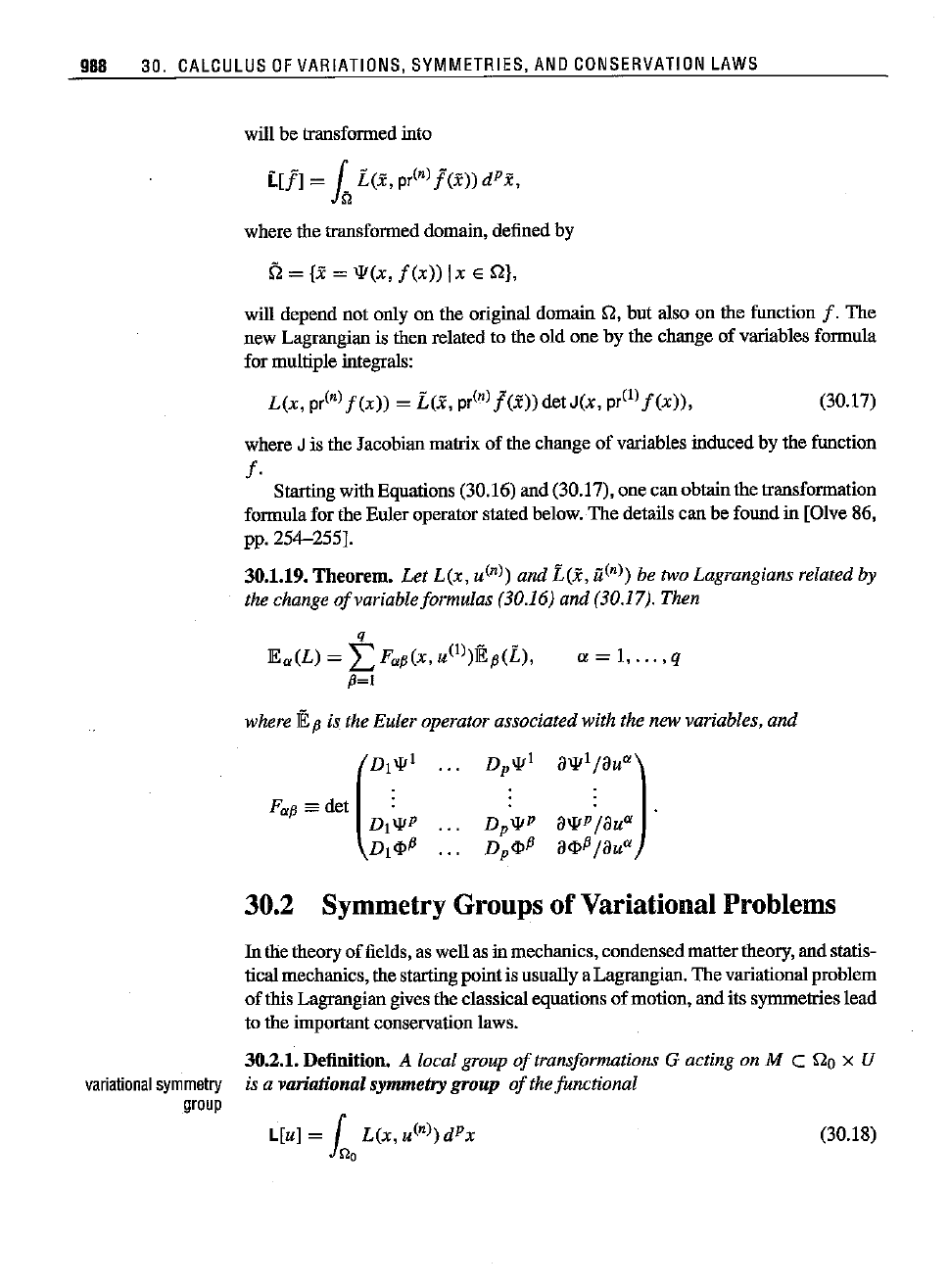
9BB
30.
CALCULUS
OF
VARIATIONS, SYMMETRIES,
ANO
CONSERVATION
LAWS
will be transformed into
where the transformed domain, defined by
Q=
Ii
=lj/(x,
f(x»
Ix E
Qj,
will
depend not only on the original domain
Q,
bnt
also on the fnnction
f.
The
new Lagrangian is then related to the old
one
by the change
of
variables formnla
for multiple integrals:
L(x,
pr(n)
f(x))
=
L(i,
pr(n)
!(i))detJ(x,
pr
el
)
f(x))
,
(30.17)
where J is the Jacobian matrix
of
the change
of
variables induced by the fnnction
f·
Startingwith Equations (30.16) and (30.17),
one
can obtainthe transformation
formula for the Euler operator stated below.
The
details can be fonnd in [Olve 86,
pp.
254-255j.
30.1.19. Theorem. Let
L(x,
u(n) and
L(i,
a(n) be two Lagrangians related by
the change
of
variableformulas (30.16) and (30.17). Then
ex
= 1,
...
,q
where
IE
p is the Euler operator associated with the new variables, and
30.2 Symmetry Groups
of
Variational Problems
In
the theory
of
fields, as well asin mechanics, condensedmattertheory, and statis-
tical mechanics, the startingpointis usuallya Lagrangian.
The
variationalproblem
of
this Lagrangian gives the classical equations
of
motion, and its symmetries lead
tothe
important
conservation laws.
30.2.1. Definition. A local group
of
transformations G acting on M C Qo x U
variational
symmetry
is a variational symmetry group
of
thejunctional
group
(30.18)

(30.19)
"Symmetry
ofthe
Lagrangian"
is
really
the
symmetry
group
ofthe
variational
problem!
30.2
SYMMETRY
GROUPS
OF
VARIATIONAL
PROBLEMS
989
ifwhenever (the closure of)
Qlies
in Qo, f is afunction over Q whose graph is in
M, and g
EGis
such that j = g . f is a single-valuedfunction defined over fl,
then
In
L(Ji,
pr(n)
j(Ji))
dPJi = l
L(x,
pr(n)
f(x))
dPx.
In
the physics community, the symmetry group
of
the variational problem is
(somewhat erroneously) called the
symmetry
of
the
Lagrangian.
Note that if we
had used
L in the LHS of Equation (30.19), we would have obtained an identity
valid for
all lagrangians because
of
Equation (30.17) and the formula for the
change in the volume element of integration. Ouly
symmetric Lagrangians will
satisfy Equation (30.19).
As we have experienced so far, the action
of
a group can be very compli-
cated and very noulinear. On the other hand, the
infinitesimal action simplifies
the problem considerably. Fortunately, we have (see [Olve 86, pp. 257-258] for a
proof).
30.2.2.
Theorem.
A local group
of
transformations G acting on M C Qo x U is
a variational symmetry group
of
the functional (30.18)
if
and
only
if
pr(n)v(L) +
LD
. X = 0
for
all (x, u(n») E
M(n)
and
every infinitesimal generator
P a q a
V=
LXi(x,u)-.
+
LUa(x,u)-----;;
;=1
ax'
a=l
au
(30.20)
ofG,
where X sa (Xl,
...
, X
P
).
30.2.3.
Example.
Considerthe case of p = I = q, and assumethatthe Lagrangian is
independent
of x but
depends
onU E C
2
(a , b) andits
first
derivative.
Thenthe
variational
problem
takes
the
form
L[u] = 1
b
L(u(l»)dx
es 1
b
L(u,ux)dx.
Since
derivatives
are
independent
of translations, we expect
translations
to be
part
of the
symmetry
group
ofthis
variational
problem.
Letus verifythis.The
infinitesimal
generator
of
translation
is
ax,
whichis its own prolongation. Therefore, with X = 1 and U = 0, it
follows
that
pr(l)v(L) +
LD·
X =
"xL
+
LDxX
= 0
+0
=
O.
III
30.2.4.
Example.
As a less trivialcase, considerthe propertime of Example30.1.15.
Lorentz
transformations
generated
by3 v = u8
x
+x8
u
aresymmetries of that
variational
310
order
to
avoid
Confusion
in
applying
formula
(30.20), we use x
(instead
of t) as the
independent
variable
andu
(instead
of x) asthe
dependent
variable.

990
30.
CALCULUS
OF
VARIATIONS, SYMMETRIES,
ANO
CONSERVATION
LAWS
problem.
Wecanverifythisby
noting
that
the
first
prolongation
of v is, as the
reader
is
urgedto verify,
Therefore,
pr(l)vCL)=
0+0+
CC1-
uin!c-
2u
x) R =
-ux)l-
u1.
1-
ui
Onthe
other
hand,
sinceX = u andU = x,
LDxCX) = )1-u1
DxCu)
= )1-u1u
x,
sothatEqoation
C30.20)
is
satisfied.
III
(30.21)
Symmetries
ofthe
Euler-Lagrange
equations
are
not
necessarily
the
symmetries
ofthe
corresponding
variational
probleml
In
the last chapter, we studied the symmetries
of
the DEs in some detail. This
chapter introduces us to a particular DE that arises from a variational problem,
namely, the Euler-Lagrange equation. The natural question to ask now is, How
does the variational symmetry manifest itself in the Euler-Lagrange equation?
Barring some technical difficulties, we note that for any change
of
variables,
if
u =
f(x)
is an extremal of the variational problem L[u], then il = lei) is an
extremalof the variational problem
[[
il].
In particular, if the changeis achieved by
the action of the variational symmetry group,
(i,
il)
= g . (x, u) for some g E G,
theu [[il]
= L[il], and g . f is also an extremal
of
L.We thus have
30.2.5.
Theorem.
If
G is the variational symmetry group
of
afunctional, then G
is also the symmetry group
of
the associatedEuler-Lagrange equations.
The converse is not troe! There are symmetry groups of the Euler-Lagrange
equations that are not the symmetry group
of
the variational problem. Problem
30.8 illustrates this for
p =3, q =
I,
and the functional
L[u] =
~fff(ul-u;
-u~)dxdydt,
whose Euler-Lagrangeequationis the wave equation. The reader is asked to show
that while therotationsand Lorentzboosts
of
Table 29.3 arevariationalsymmetries,
the dilatations and inversions (special conformal transformations) are not.
We now treat the case
of
p = 1 = q, whose Euler-Lagrange equation is
an ODE. Recall that the koowledge
of
a symmetry group of an ODE led to a
reduction in the order of that ODE. Let us see what happens in the present case.
Suppose v
= xa
x
+
ua"
is the infinitesimal generator of a l-parameter group
of
variational symmetries of L.By an appropriate coordinate transformation from
(x, u) to (y, w), as in Section 29.5, v will reduce to
a/aw,
whose prolongation
is
alsoa/aw.
In
terms of the new coordinates, Equation (30.20) will reduce to

30.2
SYMMETRY
GROUPS
OF
VARIATIONAL
PROBLEMS
991
aL/aw = 0; i.e., the new Lagrangianis independent
of
w, and the Euler-Lagrange
equation (30.14) becomes
(30.22)
Therefore, the expression in the brackets is some constant A(because
D
y
is a total
derivative). Furthermore, if we introduce v = w
y
, the expression in the brackets
becomes the Euler-Lagrange equation of the variational problem
t[v]
= f
t(y,
v(n-I»
dy,
,
(n-I)
-
where
L(y,
v ) =
L(y,
w
y
,
••.
, w
n
),
(30.23)
and every solution
w = f (y) of the original(2n)th-orderEuler-Lagrangeequation
corresponds to the
(2n - 2)nd-order equation
" at
n-I
. at
JE(L) = - +
L(-Dy)J-
= A.
ay
j=1
aVj
.
Moreover, this equation can be written as the Euler-Lagrange equation for
tA[v]
= f
[t(y,
v(n-I» - AV]
dy,
Lagrange
multiplier
and A can be thought
of
as a
Lagrange
multiplier,
so that in analogy with the
multivariable extremal problem," the extremization of
tA[v]
becomes equivalent
to that
of
t[v]
subject to the constraint Jv
dy
=
O.
We summarize the foregoing
discussion in thefollowing
theorem.
30.2.6.
Theorem.
Let p = I = q,
and
L[u] an nth-order variational problem
with a i-parameter groupof variational symmetries G. Then there exists a one-
parameter family
of
variational problems t
A
[v]
of
order n - I such that every
solution
of
the Euler-Lagrange equationfor L[u] can
befound
by integrating the
solutions to the Euler-Lagrange equation for
tA[v].
Thus, we have the following importantresult:
30.2.7. Box.
A i-parameter variational symmetry
of
a functional reduces
the order
of
the corresponding Euler-Lagrange equation by two.
This conclusionis to be contrastedwith the symmetry
of
ODEs, where each 1-
parametergroup of symmetries reduces the order
of
the ODE by 1.
It
follows from
4See
[Math
70.pp-331-341] foradiscussionofLagrange
multipliers
andtheirusein
variational
techniques,
especiallythose
used
in
approximating
-solutions of theSchrodinger
equation.
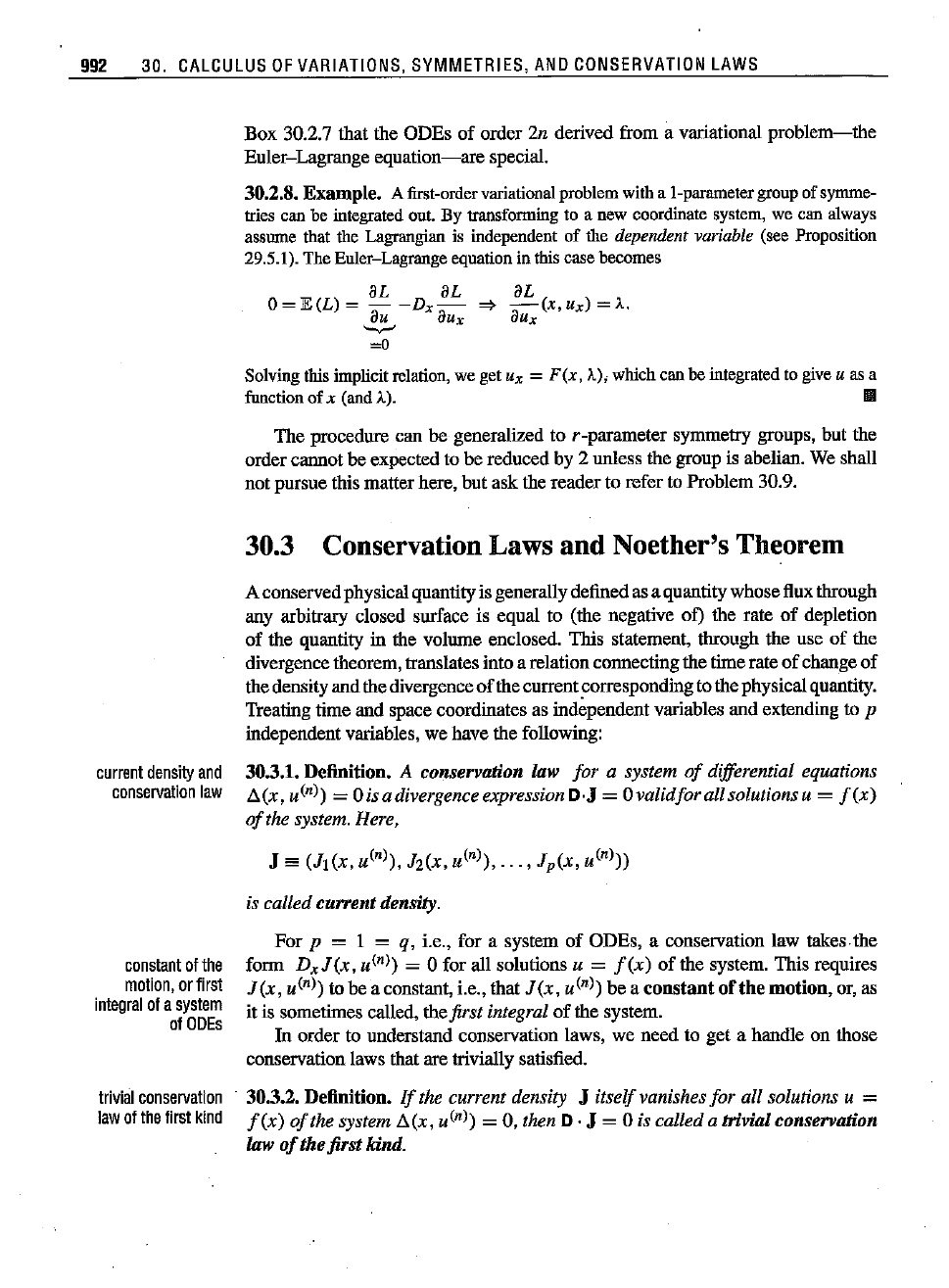
aL
=}
-(x,
ux) = A.
aux
992
30.
CALCULUS
OF
VARIATIONS, SYMMETRIES,
AND
CONSERVATION
LAWS
Box 30.2.7 that the ODEs of order 2n derived from a variational
problem-the
Euler-Lagrange equation-are special.
30.2.8. Example. A
first-order
variational
problem
witb
a
I-parameter
group
of
symme-
tries can be integrated out. By transfonning to a new coordinate system, we can always
asswne that the Lagrangian is independent of the
dependent variable (see Proposition
29.5.1). The
Euler-Lagrange
equation
in
tbis
case
becomes
st.
az,
O=lE(L)
=
--D
x
-
au
aux
'-or-'
=0
Solving this implicit relation, we get Ux =F (x, ).,);whichcan be integrated to give u as a
function
ofx
(and A). III
The procedure can be generalized to r-parameter symmetry groups, but the
order carmotbe expectedto be reduced by
2 unless the group is abelian.Weshall
not pursue this matterhere, but ask thereader to refer to Problem 30.9.
30.3 Conservation Laws
and
Noether's Theorem
A conservedphysicalquantityis generallydefinedasaquantitywhosefluxthrough
any arbitrary closed surface is equal to (the negative of) the rate of depletion
of the quantity in the volume enclosed. This statement, through the use of the
divergencetheorem,translatesintoa relationconnectingthe timerateof changeof
thedensityandthedivergenceofthecurrent
~orresponding
tothephysicalquantity.
Treatingtime and spacecoordinatesas independentvariablesand extendingto p
independentvariables,we have the following:
current
density
and
30.3.1.Definition. A conservation law
for
a system
of
differential equations
conservation
law
<lex,
u(n»)
= 0isa divergence expression D·J = ovalidforall solutionsu =
f(x)
of
the system. Here,
constant
of
the
motion,
or
first
integral
of
a
system
of
ODEs
trivial
conservation
iaw
of
the
first
kind
is called currentdensity.
For p = I = q, i.e., for a system of ODEs, a conservation law takes the
form
DxJ(x,
u(n») = 0 for all solutions u =
f(x)
of the system. This requires
J (x,
u(n»)
tobe a constant,i.e.,that J (x,
u(n»)
be a constantor the motion, or,as
it is sometimescalled,the
first integral of the system.
In order to understand conservation laws, we need to get a handle on those
conservationlaws that are triviallysatisfied.
30.3.2. Definition.
If
the current density J itselfvanishes
for
all solutions u =
fix)
of
the system <l(x,
u(n»)
= 0, then D· J = 0 is called a trivial conservation
law
of
the first kind.
